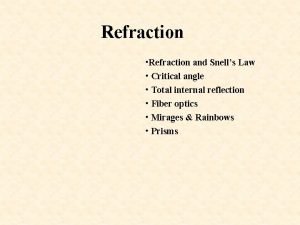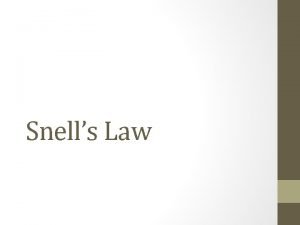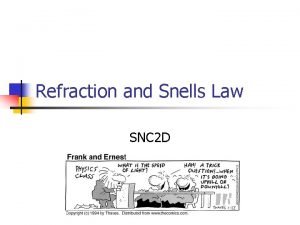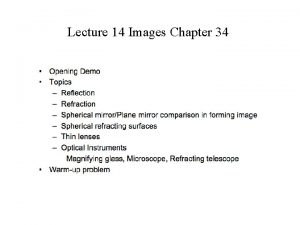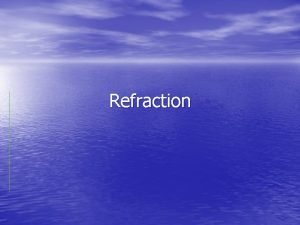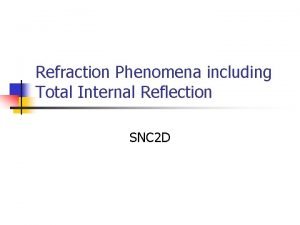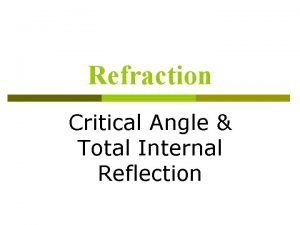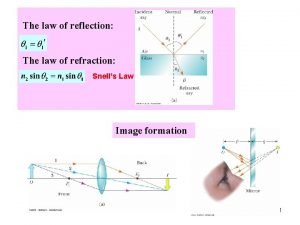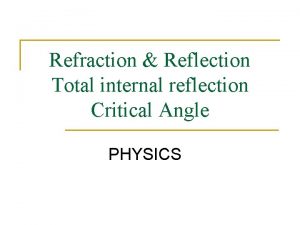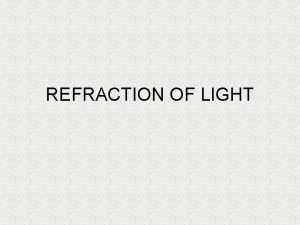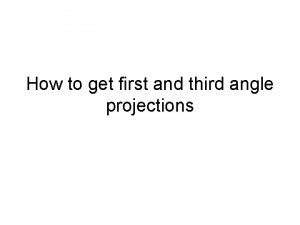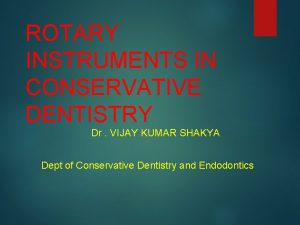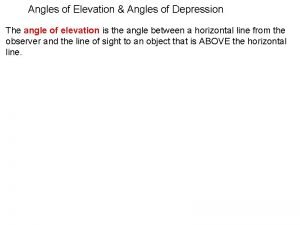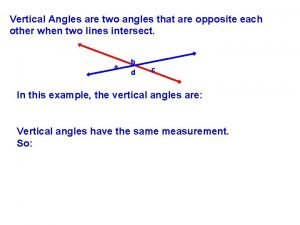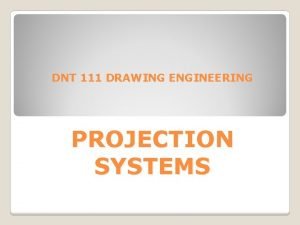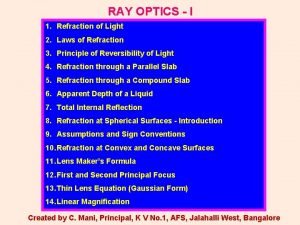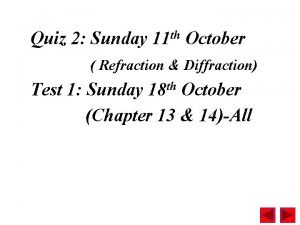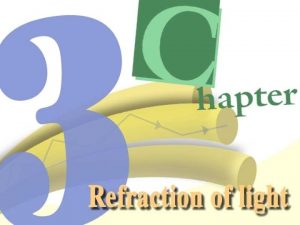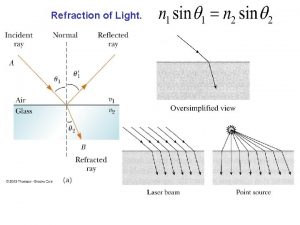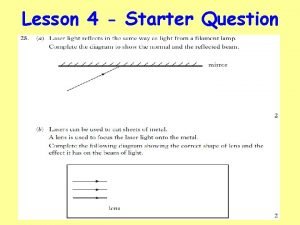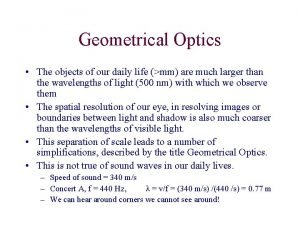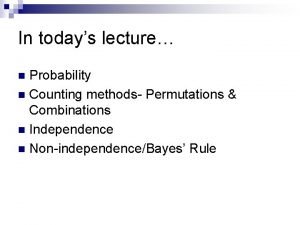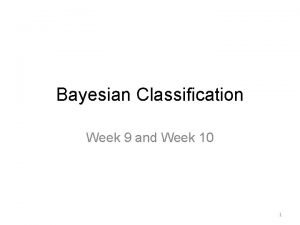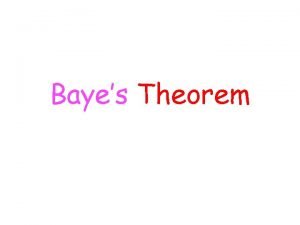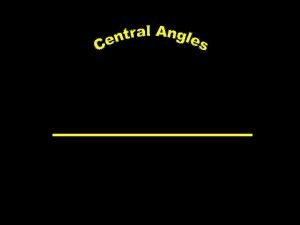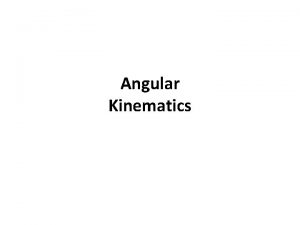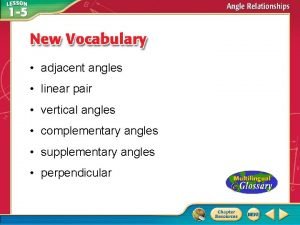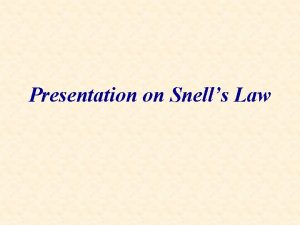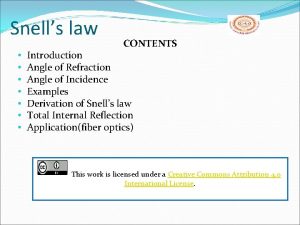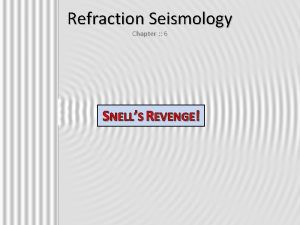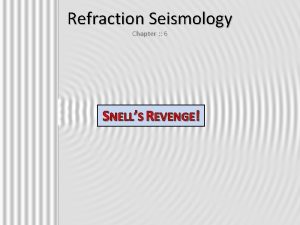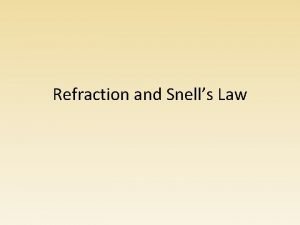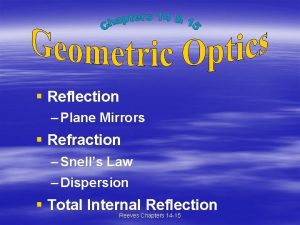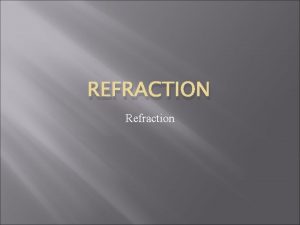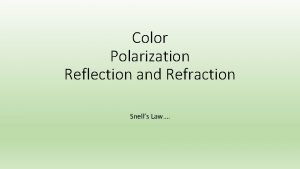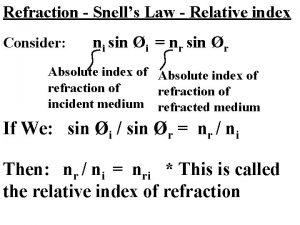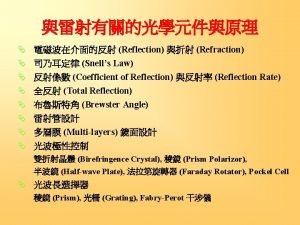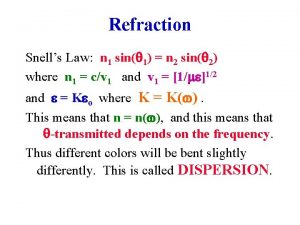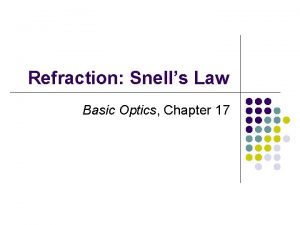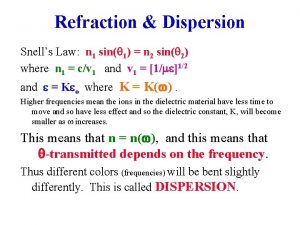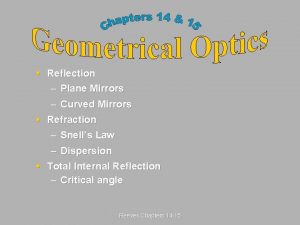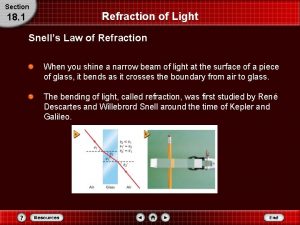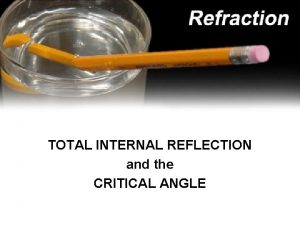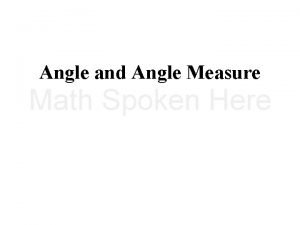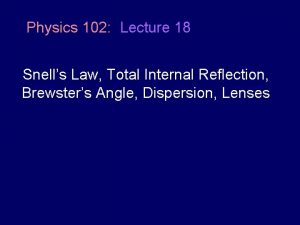Refraction Refraction and Snells Law Critical angle Total
















































- Slides: 48

Refraction • Refraction and Snell’s Law • Critical angle • Total internal reflection • Fiber optics • Mirages & Rainbows • Prisms

Speed of Light & Refraction light travels at 3. 0 108 m/s in a vacuum. Light is slowed down by the presence of matter. Light travels at about 3/4 of its vacuum speed (0. 75 c ) in water and about 2/3 its vacuum speed (0. 67 c ) in glass. The slowing occurs when light strikes an atom and interacts with its electron cloud.

Refraction When light travels from one medium to another, and the speeds in these media differ, it refracts or changes direction at the interface.


Reflection & Refraction At an interface between two media, both reflection and refraction can occur. The angles of incidence, reflection, and refraction are all measured with respect to the normal. The angles of incidence and reflection are always the same.

Refraction If light speeds up upon entering a new medium, the angle of refraction, r , will be greater than the angle of incidence.

Refraction When light slows down in the new medium, r will be less than the angle of incidence,

Refraction Phet: simulation of refraction

Index of Refraction, n The index of refraction of a substance is the ratio of the speed in light in a vacuum to the speed of light in that substance: c n= v n = Index of Refraction c = Speed of light in vacuum v = Speed of light in medium

Index of Refraction, n Note that a large index of refraction corresponds to a relatively slow light speed in that medium. Medium n Vacuum 1 Air (STP) 1. 00029 Water (20º C) 1. 33 Ethanol 1. 36 Crown Glass ~1. 5 Diamond 2. 42

Snell’s Law i Willebrord Snell r ni nr Snell’s law states that a ray of light bends so that the ratio of the sine of the angle of incidence to the sine of the angle of refraction is constant. ni sin i = nr sin r Here ni is the index of refraction in the original medium and nr is the index in the medium the light enters. i and r are the angles of incidence and refraction, respectively.

Snell’s Law Derivation n 1 x A n 2 1 A • 2 • d • y. B • B Two parallel rays are shown. Points A and B are directly opposite one another. The top pair is at one point in time, and the bottom pair after time t. The dashed lines connecting the pairs are wave fronts. In time t, point A travels a distance x, while point B travels a distance y. sin 1 = x / d, so x = d sin 1 sin 2 = y / d, so y = d sin 2 Speed of A: v 1 = x / t Speed of B: v 2 = y / t Continued…

Snell’s Law Derivation n 1 x A n 2 A • 2 • 1 d • y. B • B v 1 / c v 2 / c v 1 v 2 sin 1 = sin 2 = x/t y/t = x y 1 / n 1 1 / n 2 n 1 sin 1 = n 2 sin 1 = sin 2 = sin 1 sin 2 So, = n 2 n 1

Refraction Problem #1 Goal: Find the angular displacement of the ray after having passed through the prism. Hints: Air, n 1 = 1 30° Horiz. ray, parallel to base ø Glass, n 2 = 1. 5

Refraction Problem #1 Goal: Find the angular displacement of the ray after having passed 1. Find the first angle of refraction through the prism. Hints: using Snell’s law. 19. 4712º 2. Find angle ø. (Hint: Use Geometry skills. ) 79. 4712º Air, n 1 = 1 30° Horiz. ray, parallel to base ø 3. Find the second angle of incidence. 10. 5288º 4. Find the second angle of refraction, , using Snell’s Law Glass, n 2 = 1. 5 15. 9º

Refraction Problem #2 Goal: Find the distance the light ray displaced due to the thick window and how much time it spends in the glass. Some hints are given. 20º 1 H 20 n 1 = 1. 3 glass 10 m n 2 = 1. 5 d H 20

Refraction Problem #2 Goal: Find the distance the light ray displaced due to the thick window and how much time it spends in the glass. Some hints are given. 20º 1 1. Find 1 (just for fun). 20º H 20 2. To show incoming & outgoing n 1 = 1. 3 rays are parallel, find . 20º 10 m d 0. 504 m glass 3. Find d. n 2 = 1. 5 4. Find the time the light spends in 5. 2 · 10 -8 s the glass. H 20 Extra practice: Find if bottom medium is replaced with air. 26. 4º

Refraction Problem #3 Goal: Find the exit angle relative to the horizontal. = 19. 8° 36° air glass The triangle is isosceles. Incident ray is horizontal, parallel to the base. =?

Critical Angle The incident angle that causes the refracted ray to skim right along the boundary of a less optically dense substance is known as the critical angle, c. The critical angle is the angle of incidence that produces an angle of refraction of 90º. If the angle of incidence exceeds the critical angle, the ray is completely internally reflected. less optically dense substance nr ni c more optically dense substance

Critical Angle From Snell, n 1 sin c = n 2 sin 90 Since sin 90 = 1, we have n 1 sin c = n 2 and the critical angle is c = sin-1 nr ni c nr ni

Critical Angle Sample Problem Calculate the critical angle for the diamond-air boundary. Refer to the Index of Refraction chart for the information. air diamond c = sin-1 (nr / ni) c = sin-1 (1 / 2. 42) = 24. 4 Any light shone on this boundary beyond this angle will be reflected back into the diamond.

Total Internal Reflection Total internal reflection occurs when light is traveling from a more optically dense medium to a less optically dense medium at an angle greater than the critical angle. When this occurs there is no refraction, only reflection. n 1 n 2 > n 1 > c

Fiber Optics Fiber optic lines are strands of glass or transparent fibers that allows the transmission of light and digital information over long distances. They are used for the telephone system, the cable TV system, the internet, medical imaging, and mechanical engineering inspection. spool of optical fiber A fiber optic wire Continued…

Fiber Optics Light travels through the core of a fiber optic cable by continually reflecting off of the cladding. Due to total internal reflection, the cladding does not absorb any of the light, allowing the light to travel over great distances.

Types of optical fibers: • Single-mode fibers- transmit one signal per fiber (used in cable TV and telephones). • Multi-mode fibers- transmit multiple signals per fiber (used in computer networks). Fiber Optics Optical fibers have many advantages over copper wires. They are less expensive, thinner, lightweight, and more flexible. They aren’t flammable since they use light signals instead of electric signals. Light signals from one fiber do not interfere with signals in nearby fibers, which means clearer TV reception or phone conversations.

Fiber Optics Fiber optics are long thin strands of very pure glass. Hundreds to thousands of them are arranged in bundles (optical cables). There are three main parts to an optical fiber: • Core- the thin glass center where light travels. • Cladding- optical material (with a lower index of refraction than the core) that surrounds the core that reflects light back into the core. • Buffer Coating- plastic coating on the outside of an optical fiber to protect it from damage.

Mirage Pictures

Mirages are caused by the refracting properties of a non-uniform atmosphere. Several examples of mirages include seeing “puddles” ahead on a hot highway or in a desert and the lingering daylight after the sun is below the horizon.

Inferior Mirages A person sees a puddle ahead on the hot highway because the road heats the air above it, while the air farther above the road stays cool. The “puddle” is really just an inverted image of the sky above.

Inferior Mirages Instead of just two layers, hot and cool, there are really many layers, each slightly hotter than the layer above it. The cooler air has a slightly higher index of refraction than the warm air beneath it. Rays of light coming toward the road gradually refract further from the normal, more parallel to the road. When a ray is bent enough, it surpasses the critical angle and reflects. The ray continues to refract as it heads toward the observer. This is an example of an inferior mirage, since the cool are is above the hot air.

Superior Mirages Superior mirages occur when a layer of cool air is beneath a layer of warm air. Light rays are bent downward, which can make an object seem to be higher in the air and inverted. When the critical angle is exceeded the ray reflects. These mirages usually occur over ice, snow, or cold water. Sometimes superior images are produced without reflection.

Daylight after the sun is below the horizon or before the sun rises is another effect of refraction. Light travels at a slightly slower speed in Earth’s atmosphere than in space. As a result, sunlight is refracted by the atmosphere. Sunlight after Sunset Apparent position of sun Actual position of sun Atmosphere Observer Eart h Note: the picture greatly exaggerates this effect as well as the thickness of the atmosphere.

Dispersion of Light Dispersion is the separation of light into a spectrum by refraction. The index of refraction is actually a function of wavelength. For longer wavelengths the index is slightly small. Thus, red light refracts less than violet. (The picture is exaggerated. )

Dispersion of Light This effect causes white light to split into it spectrum of colors. Red light travels the fastest in glass, has a smaller index of refraction, and bends the least. Violet is slowed down the most, has the largest index, and bends the most. In other words: the higher the frequency, the greater the bending.

Refraction Phet: simulation of refraction for a prism

Atmospheric Optics There are many natural occurrences of light optics in our atmosphere. One of the most common of these is the rainbow, which is caused by water droplets dispersing sunlight. Others include arcs, halos, cloud iridescence.

Rainbows A rainbow is a spectrum formed when sunlight is dispersed by water droplets in the atmosphere. Sunlight incident on a water droplet is refracted. Because of dispersion, each color is refracted at a slightly different angle. At the back surface of the droplet, the light undergoes total internal reflection. On the way out of the droplet, the light is once more refracted and dispersed.

Rainbows Although each droplet produces a complete spectrum, an observer will only see a certain wavelength of light from each droplet. (The wavelength depends on the relative positions of the sun, droplet, and observer. ) Because there are millions of droplets in the sky, a complete spectrum is seen. The droplets reflecting red light make an angle of 42 o with respect to the direction of the sun’s rays; the droplets reflecting violet light make an angle of 40 o.

Rainbows

Rainbows Violet rays from high drops pass overhead Red rays from lower drops strike below eyes

Primary Rainbow

Rainbow Simulation of how a rainbow forms Phet: simulation of refraction for a rain drop

Secondary Rainbow The secondary rainbow is a rainbow of radius 51 , occasionally visible outside the primary rainbow. It is produced when the light entering a cloud droplet is reflected twice internally and then exits the droplet. The color spectrum is reversed in respect to the primary rainbow, with red appearing on its inner edge. Secondary Primary Alexander’s dark region



Credits Snork pics: http: //www. geocities. com/Enchanted. Forest/Cottage/7352/indosnor. html Snorks icons: http: //www. iconarchive. com/icon/cartoon/snorks_by_pino/ Snork seahorse pic: http: //members. aol. com/discopanth/private/snork. jpg Mirror, Lens, and Eye pics: http: //www. physicsclassroom. com/ Refracting Telescope pic: http: //csep 10. phys. utk. edu/astr 162/lect/light/refracting. html Reflecting Telescope pic: http: //csep 10. phys. utk. edu/astr 162/lect/light/reflecting. html Fiber Optics: http: //www. howstuffworks. com/fiber-optic. htm Willebrord Snell and Christiaan Huygens pics: http: //micro. magnet. fsu. edu/optics/timeline/people/snell. html Chromatic Aberrations: http: //www. dpreview. com/learn/Glossary/Optical/Chromatic_Aberrations_01. htm Mirage Diagrams: http: //www. islandnet. com/~see/weather/elements/mirage 1. htm Sir David Brewster pic: http: //www. brewstersociety. com/brewster_bio. html Mirage pics: http: //www. polarimage. fi/ http: //www. greatestplaces. org/mirage/desert 1. html http: //www. ac-grenoble. fr/college. ugine/physique/les%20 mirages. html Diffuse reflection: http: //www. glenbrook. k 12. il. us/gbssci/phys/Class/refln/u 13 l 1 d. html Diffraction: http: //hyperphysics. phy-astr. gsu. edu/hbase/phyopt/grating. html

Supernumerary Arcs Supernumerary arcs are faint arcs of color just inside the primary rainbow. They occur when the drops are of uniform size. If two light rays in a raindrop are scattered in the same direction but have take different paths within the drop, then they could interfere with each other constructively or destructively. The type of interference that occurs depends on the difference in distance traveled by the rays. If that difference is nearly zero or a multiple of the wavelength, it is constructive, and that color is reinforced. If the difference is close to half a wavelength, there is destructive interference.

Brewster Angle The Brewster angle is the angle of incidence the produces reflected and refracted rays that are perpendicular. From Snell, n 1 sin b = n 2 sin. n 2 α = b since + = 90º, and b + = 90º. n 1 β = since + = 90º, and + = 90º. Thus, n 1 sin b = n 2 sin = n 2 cos b tan b = n 2 / n 1 Sir David Brewster b b
 Snell law
Snell law Snell's law
Snell's law Index of refraction snell's law
Index of refraction snell's law Snell's law
Snell's law Critical semi critical and non critical instruments
Critical semi critical and non critical instruments Semi-critical
Semi-critical At what angle of incidence is the angle of refraction 90
At what angle of incidence is the angle of refraction 90 Total internal reflection definition
Total internal reflection definition Critical angle
Critical angle Snell's law
Snell's law Newton's first law and second law and third law
Newton's first law and second law and third law Newton's first law
Newton's first law Total internal refraction
Total internal refraction How to calculate angle of refraction
How to calculate angle of refraction Boyles law
Boyles law Charles law constant
Charles law constant Compare non-critical readers with critical readers.
Compare non-critical readers with critical readers. Formula de roe
Formula de roe Total revenues minus total costs equals
Total revenues minus total costs equals Total revenues minus total costs equals
Total revenues minus total costs equals Total revenues minus total costs equals
Total revenues minus total costs equals Total revenue minus total expenses
Total revenue minus total expenses First angle projection
First angle projection What is rake angle in dentistry
What is rake angle in dentistry Angle klm and angle mln are a linear pair.
Angle klm and angle mln are a linear pair. Bisectors worksheet
Bisectors worksheet Angle addition postulate examples
Angle addition postulate examples 43⁰
43⁰ Angle of elevation and angle of depression word problems
Angle of elevation and angle of depression word problems Are angle 3 and angle 6 vertical angles yes or no
Are angle 3 and angle 6 vertical angles yes or no 1st and 3rd angle projection
1st and 3rd angle projection Critical.angle formula
Critical.angle formula Diffraction quiz
Diffraction quiz Critical angle symbol
Critical angle symbol Total internal reflection in a semicircular glass block
Total internal reflection in a semicircular glass block Index of refraction of jello
Index of refraction of jello Critical angle
Critical angle Total internal reflection in daily life
Total internal reflection in daily life Critical clearing angle
Critical clearing angle Critical clearing time
Critical clearing time Irregular hexagon angles
Irregular hexagon angles Law of total probability and bayes theorem
Law of total probability and bayes theorem Law of total probability and bayes theorem
Law of total probability and bayes theorem Bayes classification
Bayes classification Bayes's theorem
Bayes's theorem Aa theorem
Aa theorem Angle whose vertex is at the center
Angle whose vertex is at the center Absolute angle vs relative angle
Absolute angle vs relative angle Two vertical angles
Two vertical angles
